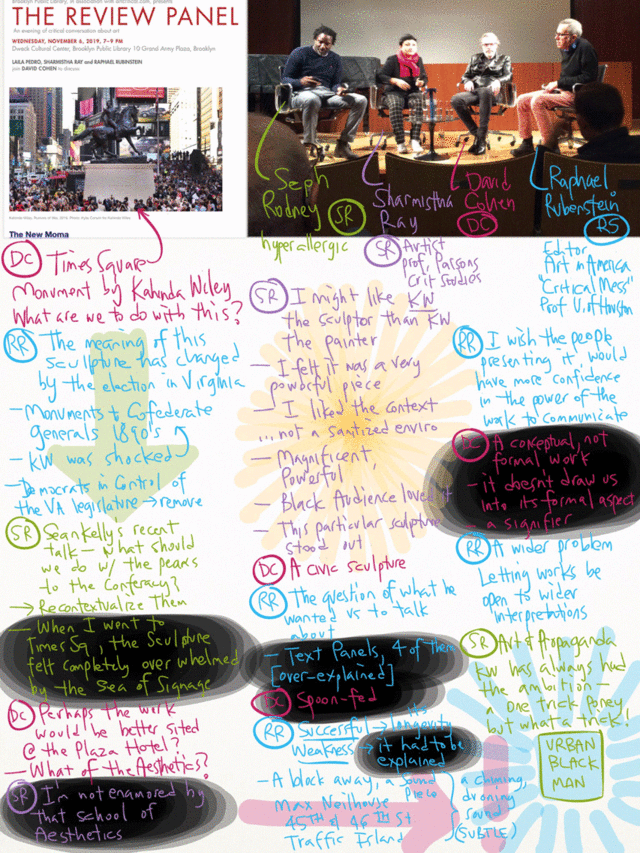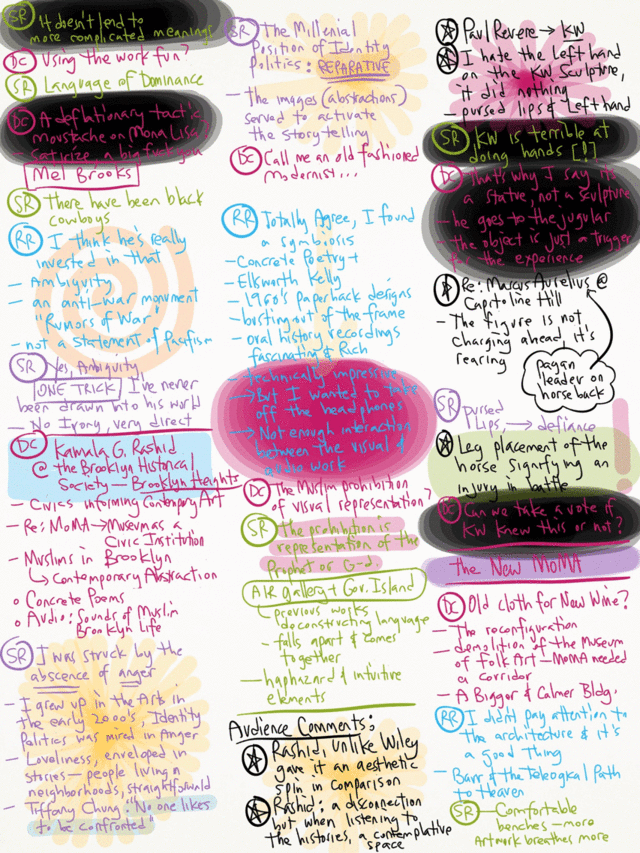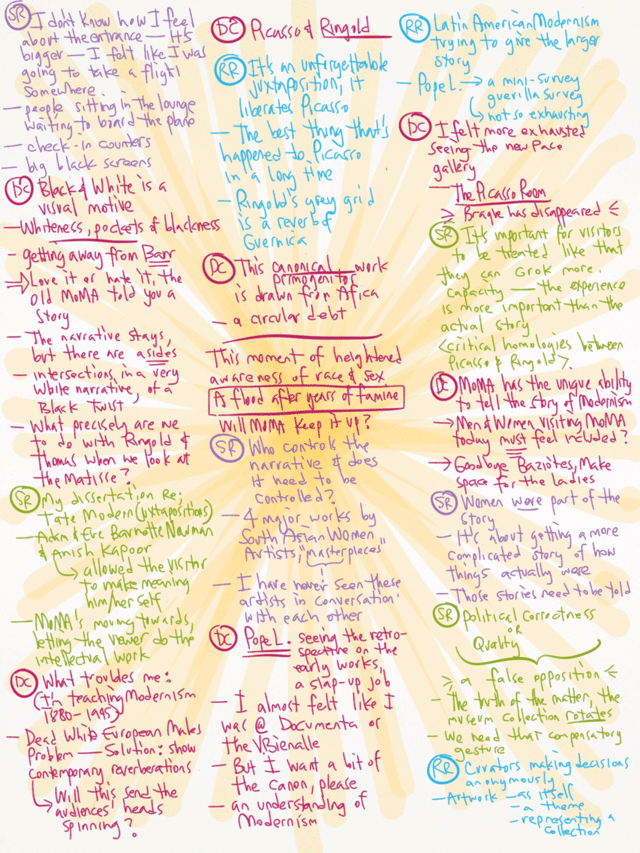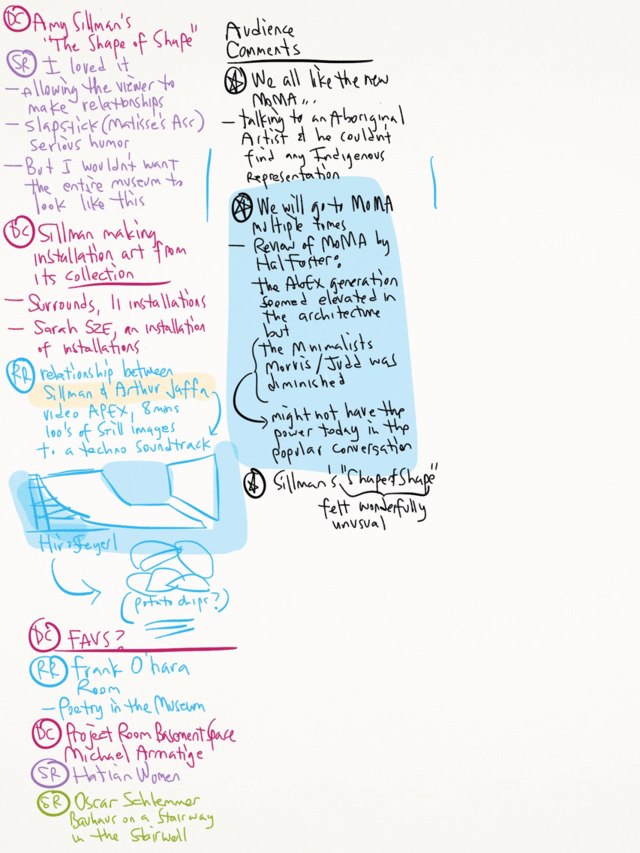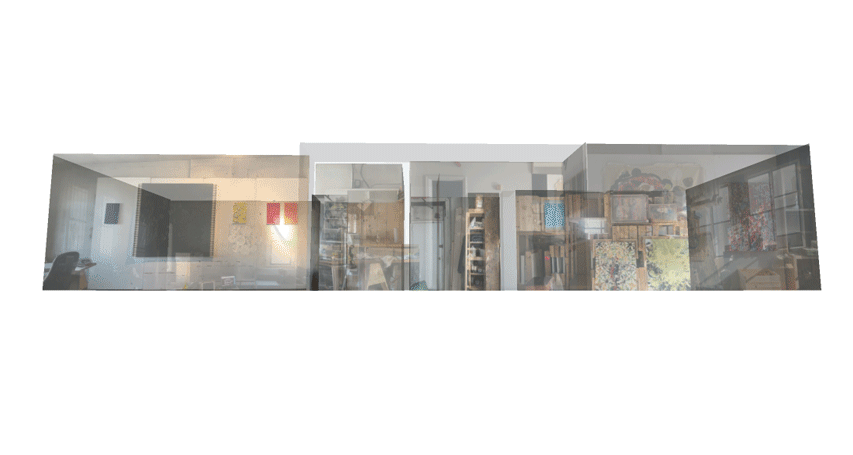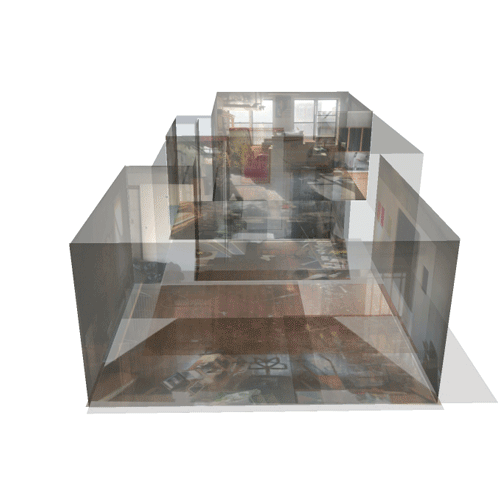November 8, 2019
Review Panel
Review Panel convened this week to consider Kehinde Wiley, Kameelah Janan Rasheed and the newly renovated MoMA. Editor and creator of the online magazine artcritical David Cohen moderated a panel including Seph Rodney, Sharmistha Ray and Raphael Rubinstein.
An Opening: Kameelah Janan Rasheed
The fruit of the evening was a comment by Sharmistha Ray, an artist and Critical Studies professor at Parsons NYC:
I grew up in the arts in the early 2000's. Identity Politics was mired in anger. [It appears that] the Millennial position about Identity Politics is [about the] reparative.
Beautiful. I hope she's right about that.
I took notes...
November 7, 2019
Modernity: Acceleration, Velocity and Control
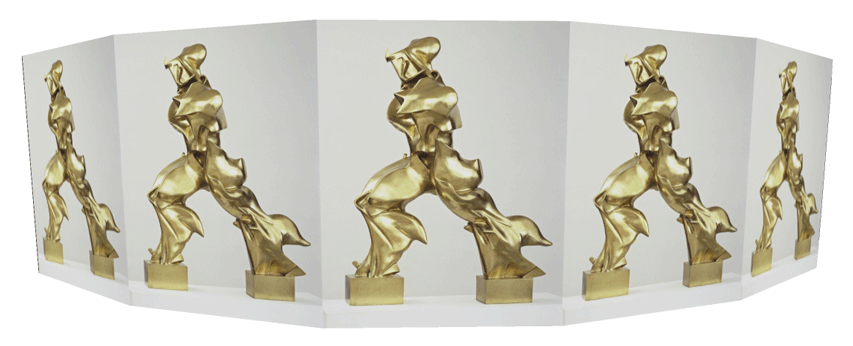
Like a little butterfly, a thought fluttered to me this morning. On my ride to the studio as I was listening to Dan Carlin's Hardcore History, "Supernova in the East" podcast #62 (Carlin's description: "The Asia-Pacific War of 1937-1945 has deep roots. It also involves a Japanese society that's been called one of the most distinctive on Earth. If there was a Japanese version of Captain America, this would be his origin story.") Carlin was describing the speed of modernization after Commodore Perry's Black Ships dropped anchor at the Ryukyu Islands in 1853.
While stopped at a red light at an intersection, listening, I admired an old Victorian building, noticing the date of its construction carved onto its' pediment, 1892, clocking over a hundred years ago. Still listening, my mind wandered in subroutine, recalling the children's song about Columbus, making the easy calculation of 400 years between this building's moment of construction, 500 years to the year after I graduated from Grad school, 39 years after Japan's leap into modernity. It was simultaneously a blink of an eye and a long time ago.
I thought about 500 years into the future and of all the technological innovation that will challenge us. What will happen when CRSPR gene editing goes from important humanitarian applications (Cancer cure? End of heart disease?...) to compelling-yet-trivial desires (Ending baldness, lengthening femurs, ending aging...) to utter ridiculousness (let your mind fly...). Before I recount the next level in the subroutine, here's some background into my ideas about Modernity at its inception and now.
The emergence of Modernity was at first gradual at the beginning of the European Enlightenment and then violent with its complete an undeniable dominance at the end of the 19th century. To allegorize Newtonian mechanics, the presentation of railway to airplane to steam/oil combustion personal and oceanic transportation, of innovations in medicine (germ theory, blood transfusion, etc...), of revolutions in communication, of weapons of war, of these and a multitude of others with the subsequent concatenations and knock on effects... Modernity erupted onto the world stage with a violent acceleration of cultural change. People had to factor in new realities that to say they were astounding is to merely tip toe around its true impact.
Shock of the New, indeed.
But today, culture is moving faster than ever before. If you consider how we adopted the personal computer in the mid-90's and evolved to the brink of bitcoin and self driving cars today, a relatively short span of 25 years, it could be argued that the modernist reformatting of society is more rapid and sweeping than ever before. But we seem not to be impressed. Why is this the case?
In the dawn of Modernity, we experienced a wallop of acceleration. In this latter stage, the sensation of acceleration is mild in comparison but we are surging at an ever greater velocity than ever before. In physics, velocity is the rate of change in position with regard to a frame of reference and acceleration is the rate of change of velocity. Both are functions in time. If the frame of reference is human history and position is some harmonic combination of human flourishing and the capacity of material manipulation, then acceleration is felt impact of how society is reordered by the change induced in modernity.
If we today were to feel the same magnitude of astonishment that our great grandparents felt, say, at the first time they witnessed powered flight or heard voices over wire or out of thin air... we would have to be shaking hands with extraterrestrial aliens, or less extravagantly (but perhaps with much more impact), we could marshal the use of Cold Fusion energy production and end the limits that burning fossil fuels have thus far restrained the ambition of humanity. Until these or other examples of societal surge manifest themselves, we won't feel acceleration in the same degree as in the dawn of the 20th century... even though we are today traveling at a much higher degree of cultural velocity. To bring this home, if you think a little more deeply about the impact of the smartphone in the past twenty five years, just this data point alone, you might begin to acknowledge just how much that handful of tech has radically rearranged our lives. But we don't feel it. We have to focus and dwell on the topic to gauge its impact.
In a previous blogpost, I had anticipated that while the 20th century could be about either/or, the 21st century could be about both/and. Looking at the building's inception date mounted proudly on its pediment, I started to think that the 20th century might be about gaining the ability to control emergent technology. It's imperative that we become a little... a little more cautious and circumspect about what we will do when we can grow custom designed human beings outside of the womb, when we push the power button on real Artificial Intelligence. It's time that we matriculate from the Sorcerer's Apprentice to the status of journeyman.
November 1, 2019
Art World & Art Industry
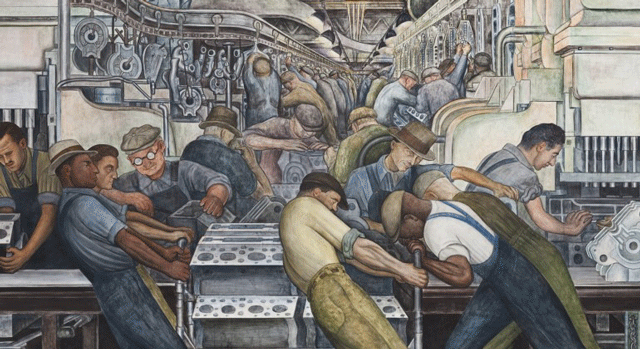
Diego Rivera's Detroit Industry murals
Where is the love?
I remember a time when it was ordinary and unexceptional to visit a fellow artist's studio and enjoy an deep conversation about art made and seen, unsullied by calculations of how to navigate the art business, of who you know, of what the depth of your network is, of some kind of inquiry into one's transactions. Of course, trade talk is normal but less so when it become clear that it is the prime motivation of a studio visit. Maybe the ideal of the art dialog was something that was natural to the community of emerging artists. Now that I am an artist long-in-tooth, perhaps this grace of earnest innocence is naturally a rare occurrence. Or perhaps there are deeper, structural problems in today's art world?
It has always been my expectation that artists first make art work and only once this activity has been established -more than the glimmer of an oeuvre- can a career be established upon widening communitarian circles of appreciation. This assumption of mine seems to have faded in the face of a growing conception of art-as-an-industry that has taken root in recent decades. The result is that artists have increasingly shifted their focus on networking at the expense of the creation of an oeuvre which is the only ground upon an authentic matrix that art world networks can grow.
Why is this today the case?
The art world population today has exploded. The art world has grown from tribal dimensions to nation state dimensions in the blink of an eye. As recently as the 60's to the mid80's, one could easily attend all the art openings in the premier of an art season in a single evening. One could know at least by face all the major players in the art world. Today, seeing all the art exhibits that should be seen professionally is itself a full time job, and the task of selecting which shows to see is indispensable in order to carve our the time to make art in the studio. One reason for the explosion in population is the increase of wealth in the world at large. Hans Rosling illustrates this vividly.
In concert with this, the pursuit of higher education had shifted from an option to an imperative. White collar jobs were seen as inherently superior to blue collar jobs and the underlying elitist assumption went unchallenged. The recent accessibility of student loans had further lowered the barriers to garnering a university education. The question of career viability disappeared as the necessary friction for accessing debt when art departments across the country began promising to deliver the keys to career success, a question that no one in anywhere the art world really can honestly answer. A curriculum can prepare an artist with the tools to handle success but it cannot deliver a successful art career. Ultimately, no one knows the answer to that question.
As wealth and population grew, so did the world of art administration from galleries to art press to collectors to art handlers to consultants to conservators to curators to museums. The conception of the identity of the art world has changed from the artisanal to the industrial. The shear dimension and complexity helped inculcate the idea of an art industry as the interlocking administrative parts articulated themselves in time. As the reality of the professional matrix took hold, the activity of networking networks had taken a life of its own. The imperative of survival within the vast art complex mandates that this must be so.
The idea of industry is incipient within Modern art. Modernity was born in the Industrial Revolution and the Enlightenment that had spawned it. Innovations in transportation, architecture, city planning, communication, war, medicine, among other sectors had exploded the viability of the Classical canon. It is interesting that it had taken over a hundred years for the model of the artist to be beguiled to migrate from the artisanal to the industrial. For the majority of the Modern epoch, artists had addressed the consequential sequential ruptures of societal change in the solitude of their studios. The art world finally seems to be emulating the industrialization that had provoked the birth of Modernity. (Within Modernity, I include both the twins Modern and Postmodern, by the way.) Process, assembly and the delegation of tasks are now normative ideas. The problem and opportunity of industry is the segmentation of process into interchangeable outsourced re-combinatorial units (1). Whereas in an artisanal economy, linkages chained a dependency of all task units together and as in a train, the "locomotive" is the source of inspiration, the generative creative spark of the whole enterprise. But in industry, as many task units that can be delegated are delegated both within and especially outside of the enterprise. The autonomy of the elements of a process endows each with a sense of equality approaching independence. Therefore the original generative spark becomes less influential, less the locomotive it was in an artisanal world. Opinion makers in the art world today are talking spiritedly about how artists are really entrepreneurs (2), without much thought that this business model is based on the actions of spotting a societal need and fulfilling it in a scalable manner. For the entrepreneur, inspiration is only the spark that generates the enterprise, the real objective. This is a very different reality of the artist as the solitary generator of intuition, inspiration, and imaginative vision. To illustrate the assumptions underlying this distinction, I will have to digress into a discussion of the inverse relation of art and commodity.
The art business is a very peculiar one indeed. The business of art operates on an inverse axis in relation to business in the non-art world. Art starts with the investment of intrinsic value (what the artist needs to express, art work made for its' own sake), and extrinsic value (money) may accrue afterwards. This manifestation of intrinsic interest happens first within the artist and later in radiating circles of friends, acquaintances and then to the public at large. In art, only after intrinsic interest is invested can extrinsic interest follow. Commodities, on the other hand, start with the satisfaction of extrinsic value (what people need) and they may eventually develop an intrinsic value (iconic recognition, aka: branding). The phenomena of branding could be thought of as the manifestation of intrinsic value at a mass scale, but this happens only after a widespread dispersal fueled by extrinsic motivation. Think Coca-Cola versus the generic refreshing satisfaction of a cold flavored carbonated beverage. This is a key concept lost on the art world today. The kernel of art has grown an industrial pulp because the soul of the art world remains, stubbornly so, a singular inspiration within the imagination of a singular artist. The pulpy realm is the business of art, and therefore it becomes imperative to remember the curious inverse relation of art versus art-as-commodity. To forget this ironic relation risks short circuiting the operation of value that animates the business and industry of art. This is the essence of current debates surrounding the real value of artists such as Kaws, Hirsh and Banksy. In contrast, no such commotion can be found in the informed regard of the likes of Hockney or Bacon. Any and every art object is judged on the merits of whether a kernel of invested intrinsic value. Any exotic ironic theoretical variations of the relation between the intrinsic and extrinsic motives yet bear upon the fundamental architecture of the two types of value related above. The art industry treats art as commodity and confusion abounds as a result.
The emulation of the disruption of innovation and industry has always resided within the kernel of Modern art. From the Impressionist shrug of routines of the Classical studio (painting all prima instead of glazed layers, painting outdoors instead of the atelier, painting the life around them instead of imagined gods and goddesses or subjects of antiquity) to the recent fashions of Critical Theory, "deskilling" and "Post-Studio" practice, art has always sought to kick at its' own supporting structures. Much like Wittgenstein's ladder, art habitually yearns for transcendence by kicking out the ladder beneath it. The emergence of Theory in late stage Postmodernism has been a problematic reification. Originally an import to the Americas from France, Poststructuralism and Deconstruction sought to reverse engineer a beguiling philosophy into a recipe that reigned over the meal. Artists as a result became habituated to first mapping out all possible significations of their art work prior to production. The knock on effects of this influence evaporated the intrinsic motivator of art creation, of intuition, of inspiration, the province of love itself. Romance is a ghost of what it was in the art world. As a result, gone are the collectors who collected in the same spirit as the art made by artists, creatively, with vision. It is more the norm today to read in the art press of art-as-investment, of the anticipation of resale value, of who are the top ten power players and who cashed in at the recent auction.
Where is the love?
This is the biggest question that should preoccupy our art world: where is the the love in art today? Is it possible to appeal to collectors regardless of their status to love jealously the assembly of their collection? It is possible to convince either collectors or museums that when they consider deaccession, they are precisely lowering the value of that particular art work? Is it possible for artists to again make art from a pure and jealous love of art alone, outside of any calculation of potential interpretation and career advancement? Can artists yet do this in the face of possible oblivion, the ultimate test? Yes, this is romance. In exactly what kind of world is the romantic a bad or naive quality?
All systems get gamed. The bigger the system, the bigger the game. The smaller the system, the smaller the game. The sheer magnitude of the art world and the dimensions of money it traffics in provokes manipulation. It will probably not be possible nor desirable to make the art world a smaller and therefore innocent system. (Yes, if it ever was so, the subject of another essay that I will probably never write.) But we could remember the twists of irony in the inverse systems of art and business and therefore use love as our compass in our often bewildering, beguiling world.
***
Note 1: 'Like launching a start-up': the modern day growing pains facing commercial galleries:
Laura Saenz of the contemporary Latin American gallery ProxyCo, says she and her partner Alexandra Morris conducted extensive market analysis before opening in 2017. "We made a business plan and tried to think of everything," she says, adding that "consistency" is key to developing a market for undervalued artists. From finding investors to sourcing artists and staff, and from developing an exhibition schedule to mapping out a marketing strategy, starting the gallery was like launching a start-up.(Emphasis Mine.)
Notice that "...sourcing artists..." is simply one link in a recombinantorial chain, much less the locomotive.
Note 2: Sarah Thornton: Are Artists the 21st Century Entrepreneurs?
Capricho
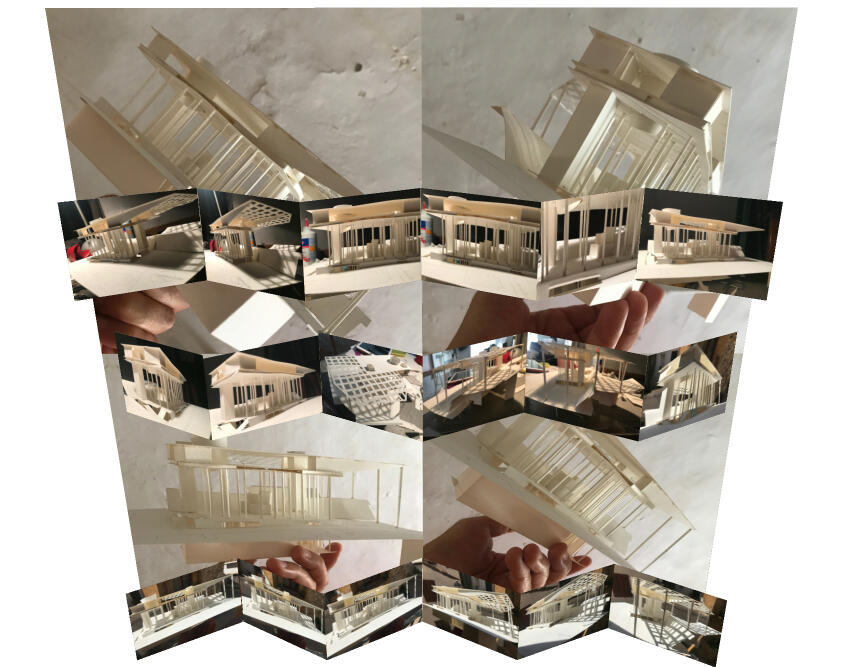
A program for the arts from the contemporary to antiquity.
A site that is more than half archeological and a renovated historic building center stage.
The ejaculatory first pass.
